Stewardship Contracting Success Story
Increasing the Capacity to Restore Savanna Ecosystems through Partnerships
Huron-Manistee National Forest
2011
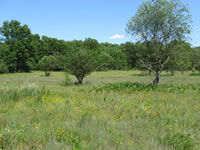
Savanna.
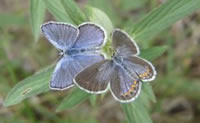
Karner blue blutterfly.
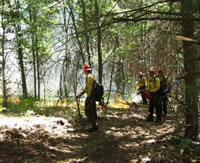
Prescribed burning.
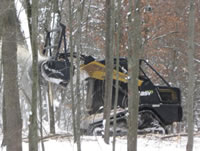
Mechanically removing vegetation.
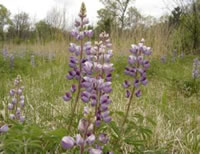
Wild lupine.
The Huron-Manistee National Forest includes a unique natural community called savanna that includes oak openings, oaks barrens, oak-pine barrens, and pine barrens. Savannas have declined over the past century due to reforestation, fire control efforts, and the process of natural succession. Many plants and animals dependent on these habitat types have decreased in numbers, including the Federally Endangered Karner blue butterfly. To recover the Karner blue butterfly on the Huron-Manistee, the Forest plans to restore and maintain 20,300 acres of savannas over the next 50 years. The restoration of savanna habitat on a landscape scale benefits numerous plant and animal species including wild turkey, golden-winged warbler, Hill's thistle, ruffed grouse, eastern box turtle, prairie smoke, American woodcock, Monarch butterfly, and white-tailed deer.
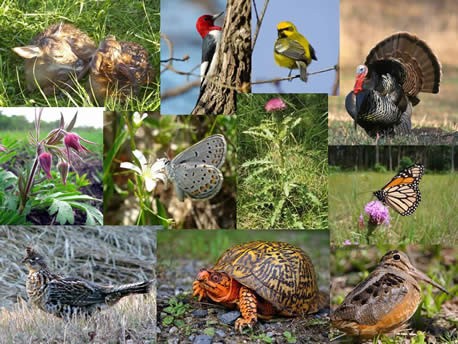 Restoring savanna habitat benefits numerous plant and animal species.
Restoring savanna habitat benefits numerous plant and animal species.
Managing and monitoring thousands of acres of savannas is a daunting task that the Forest Service cannot do alone. The Forest has been able to increase dramatically savanna restoration efforts in the last 5 years by working with partners and volunteers and leveraging agency resources. Whereas an average of 50 acres per year was managed between 1992 and 2005, an average of 271 acres per year was treated between 2006 and 2009. In 2010, the Forest conducted treatments on over 690 acres including hand cutting, prescribed burning, mechanical removal of vegetation, seeding/planting, and habitat protection. These treatments reduce tree and shrub density, protect savanna remnants, and promote growth of native grasses and wildflowers, including wild lupine, the sole food for the Karner blue butterfly caterpillar.
The Forest has amplified the capability of its restoration efforts in several ways. First, the Forest is using an adaptive management approach conducting small-scale demonstration projects to test the effectiveness of different treatment strategies to ensure the most efficient and cost effective treatments are implemented at the landscape scale. Second, the Forest is leveraging personnel and integrating program goals. Forest personnel from all resource areas, including timber, fire, recreation, trails, etc., are working together to conduct Karner blue butterfly surveys and implement treatments. Acres treated during restoration efforts contribute accomplishments to the timber, fire, wildlife, and botany programs. Third, the Forest is developing stewardship projects that allow receipts from timber sales to be retained on the Forest, increasing funding available for savanna management. Fourth, the Forest is obtaining external support such as grants, partnerships, and volunteers. In 2010, the Huron-Manistee National Forest received over $400,000 of Great Lakes Restoration Initiative and American Recovery and Reinvestment Act funds.
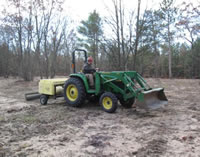
Broadcast seeding for wildlife habitat improvement.
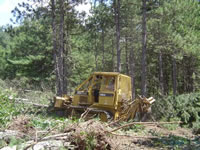
Preparing an area for aspen regeneration.
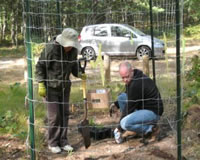
Volunteers planting native species plugs.
Partnerships have been essential to promoting savanna restoration across landscapes and jurisdictional boundaries. In 2010, the Forest expanded its partnership with the National Wild Turkey Federation by entering into an agreement to restore 377 acres of habitat. This partnership promotes ecosystem management that benefits wild turkey, Karner blue butterfly, and other savanna species. Other partnership efforts include, but are not limited to: planting nectar plugs in savanna habitat with the Michigan Wildlife Conservancy; cooperative data collection and analyses with the Michigan DNRE, The Nature Conservancy, U.S. Fish and Wildlife Service, and Consumer's Energy on private lands; and, aspen regeneration cuts adjacent to savanna restoration project areas to enhance habitat for ruffed grouse and American woodcock with the Ruffed Grouse Society and the Wildlife Management Institute.
Volunteer participation has also been key to our successful restoration efforts. Since 2007, individuals from 27 partner organizations have contributed 886 volunteer days valued at $112,300. With the help of volunteers, the Forest has dramatically increased effectiveness monitoring from an average of 298 acres per year to an average of 901 acres per year. The experience many volunteers have had while participating is multi-faceted. Many have never seen a savanna before and some are surprised to find that cactus occurs in Michigan. Not only do the volunteers learn what savannas are and why they need to be conserved, but also many become so enthusiastic about savanna restoration that they offer to help with restoration treatments. Since 2009, volunteers have planted native wildflowers improving over 50 acres of savanna habitat. This outreach effort has cultivated public support for savanna management, which has been essential given the controversy surrounding the conversion of forest to savanna on a landscape scale.
Recruiting volunteers and collaborating with partners has increased opportunities to enhance habitat management and the outdoor experiences of future generations. By working together, we increase our ability to do work on the ground. No longer bound by budgets and artificial boundaries, we are making ecosystem management on a landscape scale possible.